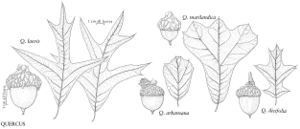Difference between revisions of "Quercus marilandica"
Hausvater 5(1): 253. 1770.
FNA>Volume Importer |
FNA>Volume Importer |
||
| Line 27: | Line 27: | ||
}}<!-- | }}<!-- | ||
| − | --><span class="statement" id="st- | + | --><span class="statement" id="st-undefined" data-properties=""><b>Trees,</b> deciduous, to 15 m. <b>Bark</b> almost black, with irregular or rectangular blocks, inner bark orangish. <b>Twigs</b> ashy brown, (1-)2-4(-5) mm diam., pubescent to tomentose. <b>Terminal</b> buds conic or narrowly ovoid-ellipsoid, 5-10 mm, noticeably 5-angled in cross section, tawny pubescent. <b>Leaves</b>: petiole 5-20 mm, densely to sparsely pubescent. <b>Leaf</b> blade obovate to obtrullate, (50-)70-200 × (40-)70-200 mm, base rounded or cordate, blade not decurrent, margins with 3-5 shallow, often very broad lobes and 3-10 awns, apex acute to obtuse, rarely rounded; surfaces abaxially scurfy or with scattered pubescence, adaxially glossy, glabrous, secondary veins raised on both surfaces. <b>Acorns</b> biennial; cup turbinate, 6-10 mm high × 13-18 mm wide, covering 1/3 nut, outer surface puberulent, inner surface pubescent, scale tips loose, especially at margin of cup, acute or acuminate; nut broadly ovoid or ellipsoid, 12-20 × 10-18 mm, often striate, glabrate, scar diam. 5-8 mm. <b>2n</b> = 12. [R. C. <b>Friesner</b> 1930. J. W. <b>Duffield</b> (1940) suggested that Friesner was counting bivalents; if so, then 2n = 24, consistent with all other reports for Quercus.]</span><!-- |
-->{{Treatment/Body | -->{{Treatment/Body | ||
| Line 60: | Line 60: | ||
|publication year=1770 | |publication year=1770 | ||
|special status=Endemic;Selected by author to be illustrated;Weedy | |special status=Endemic;Selected by author to be illustrated;Weedy | ||
| − | |source xml=https://jpend@bitbucket.org/aafc-mbb/fna- | + | |source xml=https://jpend@bitbucket.org/aafc-mbb/fna-data-curation.git/src/9216fc802291cd3df363fd52122300479582ede7/coarse_grained_fna_xml/V3/V3_901.xml |
|genus=Quercus | |genus=Quercus | ||
|section=Quercus sect. Lobatae | |section=Quercus sect. Lobatae | ||
|species=Quercus marilandica | |species=Quercus marilandica | ||
| − | |||
| − | |||
| − | |||
| − | |||
| − | |||
| − | |||
| − | |||
| − | |||
| − | |||
| − | |||
| − | |||
| − | |||
| − | |||
| − | |||
| − | |||
| − | |||
| − | |||
| − | |||
| − | |||
| − | |||
| − | |||
| − | |||
| − | |||
| − | |||
| − | |||
| − | |||
| − | |||
| − | |||
| − | |||
| − | |||
| − | |||
| − | |||
| − | |||
| − | |||
| − | |||
| − | |||
| − | |||
| − | |||
| − | |||
| − | |||
| − | |||
| − | |||
| − | |||
| − | |||
| − | |||
| − | |||
}}<!-- | }}<!-- | ||
-->[[Category:Treatment]][[Category:Quercus sect. Lobatae]] | -->[[Category:Treatment]][[Category:Quercus sect. Lobatae]] | ||
Revision as of 13:53, 27 July 2019
Trees, deciduous, to 15 m. Bark almost black, with irregular or rectangular blocks, inner bark orangish. Twigs ashy brown, (1-)2-4(-5) mm diam., pubescent to tomentose. Terminal buds conic or narrowly ovoid-ellipsoid, 5-10 mm, noticeably 5-angled in cross section, tawny pubescent. Leaves: petiole 5-20 mm, densely to sparsely pubescent. Leaf blade obovate to obtrullate, (50-)70-200 × (40-)70-200 mm, base rounded or cordate, blade not decurrent, margins with 3-5 shallow, often very broad lobes and 3-10 awns, apex acute to obtuse, rarely rounded; surfaces abaxially scurfy or with scattered pubescence, adaxially glossy, glabrous, secondary veins raised on both surfaces. Acorns biennial; cup turbinate, 6-10 mm high × 13-18 mm wide, covering 1/3 nut, outer surface puberulent, inner surface pubescent, scale tips loose, especially at margin of cup, acute or acuminate; nut broadly ovoid or ellipsoid, 12-20 × 10-18 mm, often striate, glabrate, scar diam. 5-8 mm. 2n = 12. [R. C. Friesner 1930. J. W. Duffield (1940) suggested that Friesner was counting bivalents; if so, then 2n = 24, consistent with all other reports for Quercus.]
Phenology: Flowering spring.
Habitat: Poor shallow soils of glades, barrens and flatwoods, disturbed fields, rocky outcrops, and dry ridges
Elevation: 0-900 m
Distribution

Ala., Ark., Del., D.C., Fla., Ga., Ill., Ind., Iowa., Kans., Ky., La., Md., Miss., Mo., Nebr., N.J., N.Y., N.C., Ohio, Okla., Pa., S.C., Tenn., Tex., Va., W.Va.
Discussion
Evidence suggests that small trees from the western portion of the range (primarily Texas and Oklahoma) should be recognized as Quercus marilandica Münchhausen var. ashei Sudworth (D. M. Hunt 1989). These trees are characterized by 50-70 × 40-60 mm leaf blades with abaxial surfaces gray-tomentose in vein axils.
Quercus marilandica reportedly hybridizes with Q. buckleyi and Q. falcata (E. J. Palmer 1948); and with Q. georgiana, Q. ilicifolia (= Q. ×brittoni W. T. Davis), Q. imbricaria [= Q. ×tridentata (A. de Candolle) Engelmann], Q. incana, Q. nigra, Q. phellos (Q. ×rudkini Britton), and Q. velutina (= Q. ×bushii Sargent). D. M. Hunt (1989) cited evidence of hybridization also with Q. arkansana, Q. hemisphaerica, Q. laevis, Q. laurifolia, Q. myrtifolia, Q. palustris, and Q. rubra.
The Choctaw used Quercus marilandica to ease cramps and to aid in childbirth (D. E. Moerman 1986).
Selected References
None.
